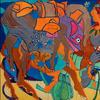Perle Fine: The Cool Series (1961–1963)
- NEW YORK, New York
- /
- November 01, 2011
Spanierman Modern is pleased to announce the opening on November 10, 2011 of Perle Fine: The Cool Series (1961-1963), presenting the distinctive Color Field paintings created by Fine, an artist who was at the center of the Abstract Expressionist movement. Developing according to Fine from “a need within the painting to express more,” the Cool Series paralleled the gestalt in the art world in the early 1960s, as artists turned from the angst of the art of an earlier generation to a more tranquil mode in which a painting, through its form and color, spoke for itself. Although new attention has been focused on Fine’s art in recent years, this is the first exhibition to feature this series since they were first seen in 1963 and 1964. Curated by Christine Berry, the show is accompanied by a catalogue, available from the gallery for $25, with full-color illustrations and an essay by Lisa N. Peters, Ph.D.
Born in Boston, Perle Fine moved to New York in about 1927, enrolling first at the Grand Central School of Art and then at the Art Students League. In 1933, she was among the first students at Hans Hofmann’s New York school; she also studied with Hofmann in Provincetown, Massachusetts. Committed to abstraction at the start of her career, Fine began to receive recognition in the early 1940s, when she showed at Peggy Guggenheim’s Art of This Century Gallery and the Museum of Nonobjective Painting (now the Solomon R. Guggenheim Museum). She was among the few women artists to become part of The Club, the elite artists’ group initiated in 1949, that was spearheaded by Franz Kline and Willem de Kooning; the latter invited Fine to join. A friend of many noted artists of the time, including Lee Krasner, Jackson Pollock, Ad Reinhardt, de Kooning, and Mark Rothko, Fine was represented by several important galleries, including those of Nierendorf, Betty Parsons, and Tanager.
In 1954, Fine moved to Springs on the east end of Long Island, where she and her husband, Maurice Berezov, built a one-room studio-house in the woods. Fine began her Cool Series in this context in 1961, creating them all of a sudden after destroying a group of works she had been producing for her next exhibition. Limiting her imagery to rectangles and squares placed off center on mostly monochromatic grounds, she sought to eliminate “irrelevancies” in order to exact an explicit and clear image. Fine’s economy of means and the universalist implications of her stable yet dynamic arrangements can be associated with her long admiration for the art of Piet Mondrian, whom she knew (in 1947, she was commissioned to create an identical copy of his last painting, Victory Boogie-Woogie). Yet her mixed and atmospheric colors depart from Mondrian’s limited palette as do her edges—which vary from crisp to blurred— endowing her work with a unique delicacy and poetic equilibrium, qualities that were given recognition by the critics of the time. With their glowing light and dignified, reductive arrangements, the Cool Series paintings express a meditative metaphysical experience. Related in their spiritual content to Mark Rothko’s late-period art, Fine’s paintings envelop the viewer in emotional experiences that are at once volatile and restrained. Created from 1961 to 1963, the Cool Series were among the first examples of Color Field painting, revealing Perle Fine’s attunement to the spirit of her time.
Fine displayed her work extensively in solo and group shows during her lifetime. Following her death from pneumonia in 1988, she was the subject of exhibitions at Hofstra University in 1974 and 2009 and at the Pollock-Krasner House and Study Center, East Hampton, New York, in 2005. Her work is represented in many numerous museum collections, including the Brooklyn Museum, New York; Corcoran Gallery, Washington, D.C.; the Metropolitan Museum of Art, New York; the National Gallery of Art, Washington, D.C.; Smithsonian American Art Museum, Washington, D.C.; Solomon R. Guggenheim Museum, New York; the Whitney Museum of American Art, New York; and many others.
Contact:
Christine BerrySpanierman Modern
212-832-1400
christineberry@spanierman.com
53 East 58th Street
New York, New York
inquiry@spaniermanmodern.com
212-832-1400
http://www.spaniermanmodern.com










100x100_n.jpg)
100x100_c.jpg)










100x100_c.jpg)

